This in-depth guide on the potato will answer all your basic questions about the culinary, nutritional and agricultural aspects of the potato.
We contacted four experts to help us answer all our questions about the potato:
Chef RJ Harvey, culinary director at Potatoes USA. His kitchen is called The Spud Lab and he is well known as The Spud Bud. He answers all the culinary questions like how you get your potatoes crispy.
Prof Hettie Schönfeldt, co-director at ARUA CoE Sustainable Food Systems (ARUA CoE = The African Research Universities Alliance’s centre of excellence). Dr. Carmen Muller, a post-doctoral fellow in nutrition, assisted Hettie in answering our questions about the nutritional aspects of the potato.
Michelle Hawksworth, a dietitian. She answers our nutritional questions about the potato.
Prof Jacquie van der Waals, a plant pathologist specializing in potatoes. She is the program manager of preharvest disease research at Citrus Research International. She is giving advice on how to grow a potato plant successfully at home.
Culinary uses of the potato
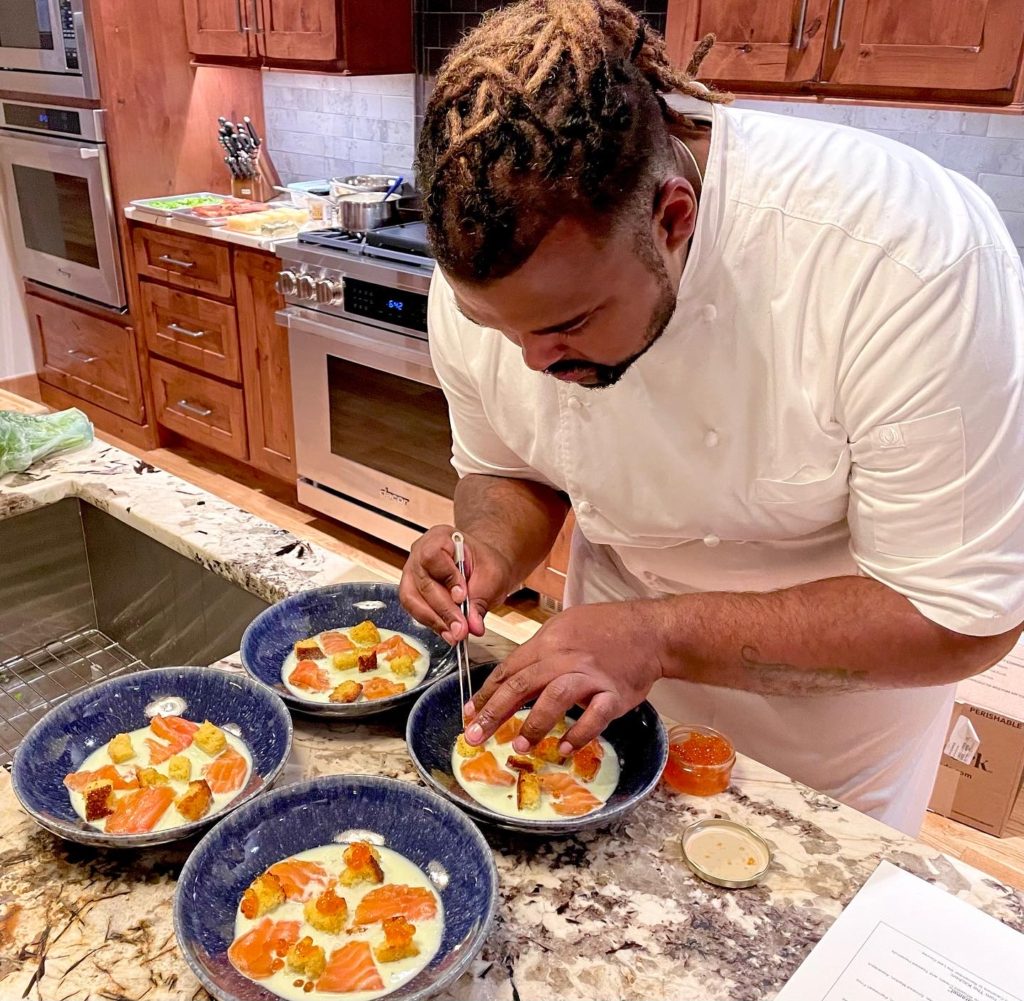
Photo: Supplied
Do we need to worry about which potato variety is most suitable to use for example mash or fries?
There are more than 200 varieties of potatoes. Each of these varieties fits into one of seven potato type categories: russet, red, white, yellow, blue/purple, fingerling, and petite.
Most potatoes are versatile enough to prepare in many ways. There certainly is nothing wrong with making fries with yellow potatoes. Or mashed potatoes with purple potatoes, or potato salad with russet potatoes.
However, certain potato varieties do tend to lend themselves better to certain preparations. The variance in starch content and the way the starch reacts when cooked, is the biggest part of the equation. Russets tend to get light and fluffy when cooked. They absorb a lot of moisture, causing them to fall apart in wet cooking methods such as stews, braises, and boiling. For this reason, russets are more suitable for baked or roasted potatoes, fries, and hash browns.
Red, yellow, or white potatoes are great for potato salads, soups, or stews because they don’t tend to break down as easily after cooking.
How do you cook crispy potatoes?
Deep-frying
For crispy potatoes, choosing the right potato is key. Russet potatoes tend to get crispy and stay crispy longer. Nearly all potatoes will get crispy but the higher the water content in the potato the shorter the shelf life of their crispiness.
The best way to crisp potatoes is certainly to deep fry them. Deep frying is an intense dry cooking method that wicks moisture out of the potato rapidly at a high temperature. By deep frying the potato, you seal the outside and create a crispy exterior that is golden brown and delicious.
When frying potatoes, it’s important to get as much water out as possible. That is why chefs all over the world use a two-stage frying technique. We first cut the potatoes and then we fry them twice. First at a lower temperature to remove moisture and fully cook the potato. Then you fry it again at a high temperature to seal the outside and make sure it is crunchy.
Baking and roasting
Baking and roasting will also yield a crispy potato, but just like frying, you want to ensure as much water gets removed as possible. Roasting potatoes on a nonstick baking sheet lightly misted with oil in a single layer at 400 °F (200 °C) is a good start. Roasting potatoes this way, will ensure a crispy exterior. I do recommend roasting potatoes on a wire rack to promote browning on all sides.
One trick we found is to fully cook potatoes first in a flavorful cooking liquid like vegetable or chicken stock. From here you can add fresh herbs, lemon, and seasonings, just to mention a few. Then for the last 5 minutes of cooking add a little baking soda (about 1 tablespoon per gallon / 3 ½ liters of water) to the water.
What this does is create a chemical reaction with the pectin in the potatoes and allow the potato to form a little “gel” around itself. When you roast it, it gets crispy with an even golden-brown color. If you do not wish to go that route, you can simply toss potatoes in a little potato or corn starch and fry the potatoes that way, and that will result in crispy golden-brown wedges as well.
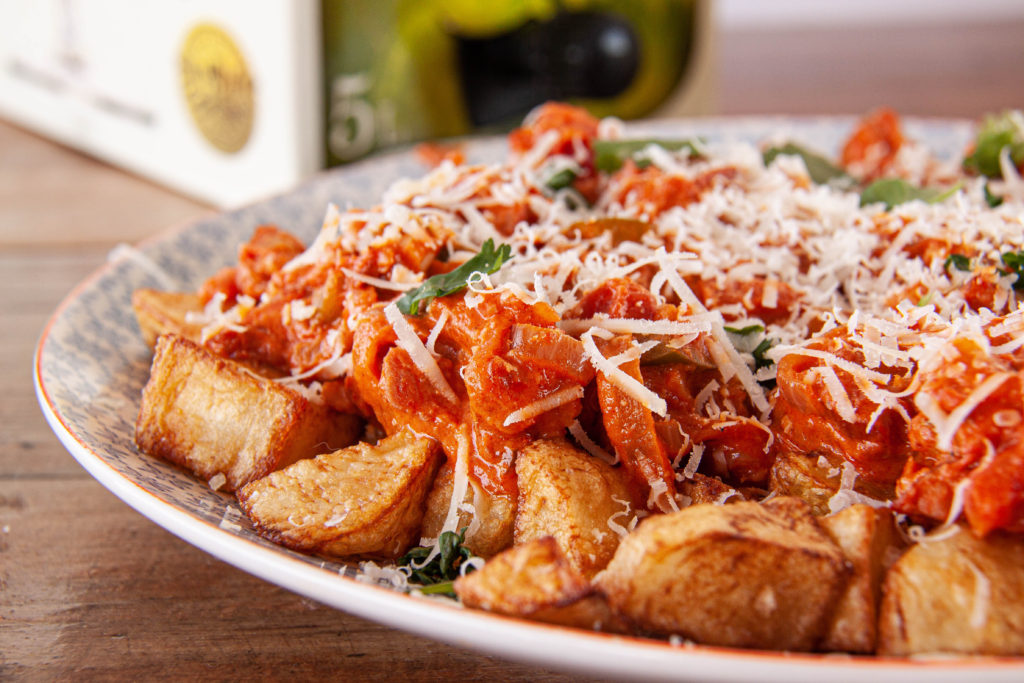
Photo: Hannes Kruger
How do you make a creamy and fluffy mash?
This comes down to three factors:
- The type of potato used.
- The type of liquid and fat used in the mashed potatoes.
- How long you cook the potatoes.
The type of potato used matters because the starch in various potato varietals reacts differently when cooked. Russet potatoes have starch granules that swell and get light and fluffy, so they result in light and fluffy mashed potatoes. Red, yellow or white potatoes lend themselves to creamier mashed potatoes.
The type of liquid or fat used influences light and fluffy versus rich and creamy as well. For light and fluffy mashed potatoes choose milk, stock, or even water along with butter or olive oil. The higher the percentage of dairy fat, the creamier and richer the mashed potatoes will be. For example, using heavy cream instead of milk will mean thicker and creamier mashed potatoes, whereas 2% milk and butter will result in lighter mashed potatoes.
The amount of time the potatoes cook is crucial. When making mashed potatoes, you need to cook the potatoes thoroughly until completely fork tender. If they are underdone you will have sticky and gluey mashed potatoes. This is because the starch hasn’t had time to fully swell. No matter what type of potato or what type of liquid fat you choose, undercooking the potatoes will always result in gluey sticky mashed potatoes.
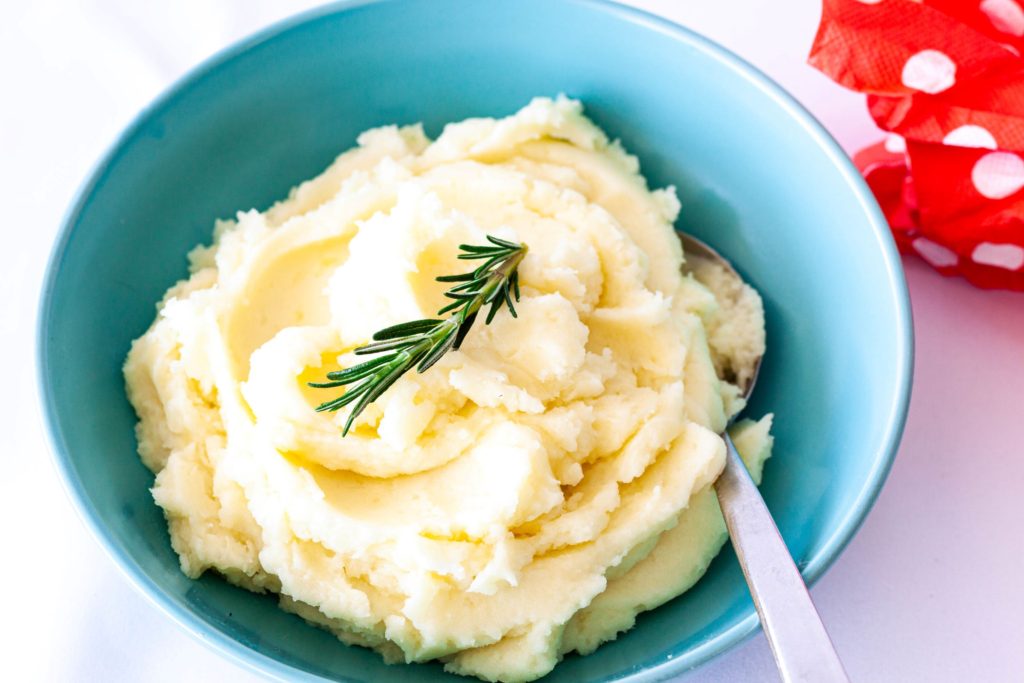
Photo: Hannes Kruger
How do I make fries from scratch at home?
Fries are easy. They only require some thought and preparation. For crispy fries, russet potatoes are the best, and a two-stage cooking process will yield ultimate results.
Partially cook or blanch the fries in water. I prefer water as you can add in other flavors as the potatoes are cooking, for example, lemon, herbs, salt, and garlic. You can also add baking soda just like I mentioned with the roasted potato wedges.
Once the potatoes are just fork tender, drain them and then spread them on a sheet pan to dry, and then freeze them. Once frozen, fry them at 375 °F (190 °C) for 4 to 6 minutes. Conversely, the fries can be par-cooked or blanched in oil, until they are fully cooked but do not get any color on them. This is achieved by doing the primary fry in low-temperature oil like 300 °F (150 °C) for about 7 to 8 minutes. After the initial fry, turn the oil temperature up to 375 °F (190 °C) and fry for 4 to 6 minutes until golden and crispy.
You can also bake fries. Simply cut your russet potatoes into batons or wedges, toss them in a little vegetable oil or olive oil, season with salt and pepper, arrange in a single layer on a non-stick baking sheet and bake at 425 °F (220 °C) for 35 to 40 minutes or until crispy (turn the fries mid-way through cooking to allow even browning).
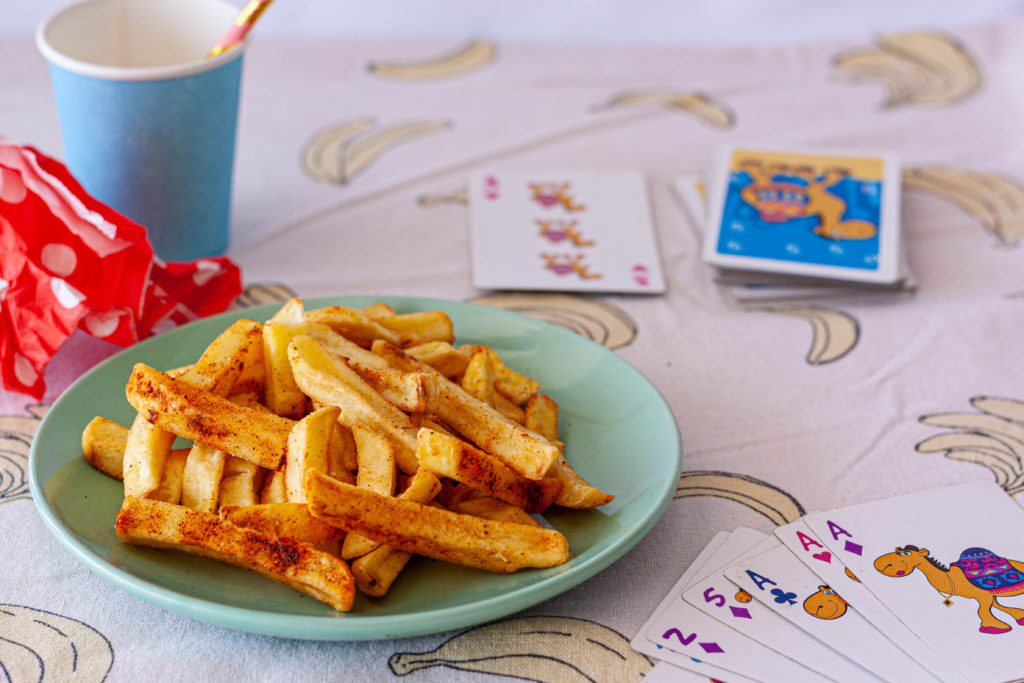
Photo: Hannes Kruger
Do we need to rinse or soak our potatoes in water before cooking them?
When dealing with a lot of potatoes, it’s a good idea to peel them and keep the whole potatoes in cold water. That said, if cutting or grating the potatoes, whether or not to soak them, depends on the final recipe and desired application for the potatoes.
For most applications (e.g. potato salad, mashed potatoes, and fries) soaking the cut potatoes is a good idea. It will remove excess starch and can reduce oxidation, and prevent undesired textures in your final dish. For other applications (e.g. hash browns, au gratin, latkes, scalloped potatoes and potato pave) you do not want to remove the starch as it helps the potatoes stick together and brown evenly.
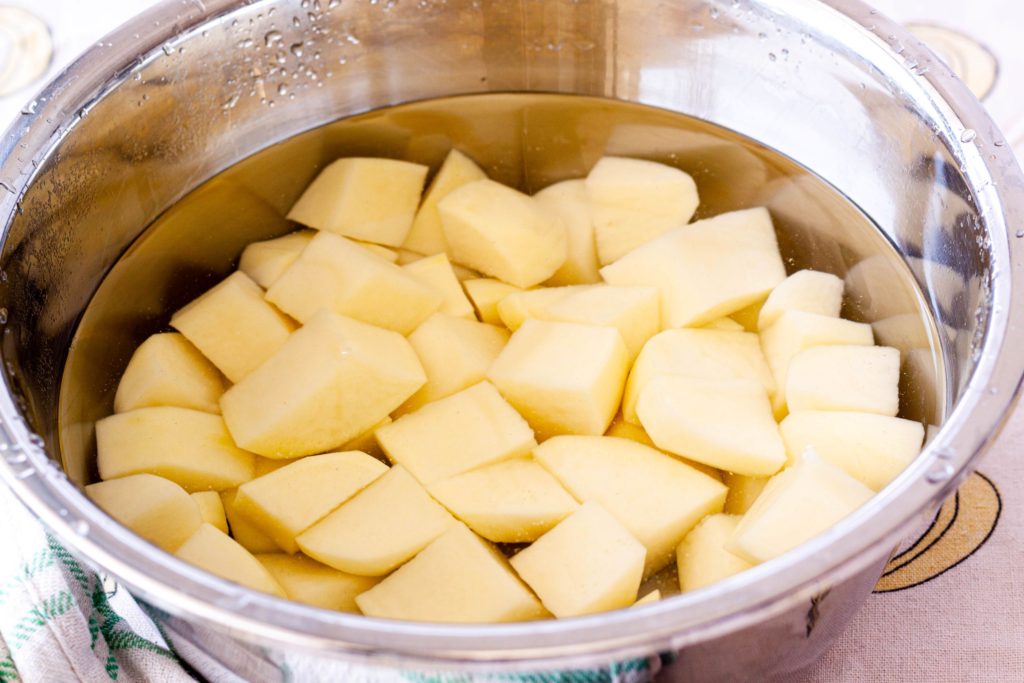
Photo: Hannes Kruger
How do you store leftover potatoes?
How you store leftover potatoes depends greatly on the finished recipe. You should cool mashed potatoes and place them into a resealable plastic freezer bag and flatten it out for easy storage in the freezer. This will ensure even thawing and frees up space in your freezer because you can easily shingle flattened bags.
Some potato recipes like hash browns are best eaten immediately as they don’t hold well under refrigeration, but blanched fries on the other hand can be frozen on a baking sheet and then transferred to a plastic freezer bag for frying at a later date.
You can dice up baked potatoes and freeze them just like fries, for an easy breakfast later. One can simply crisp them up in a skillet or put them in a fryer to crisp. You can also just roast them in the oven.
What uses are there for potatoes that have been a bit too long in the cupboard?
If they are not moldy or rotten, you can simply peel the potatoes and nick off any noticeable sprouts and discard them. Then you can cook the potatoes, using any cooking method. Slightly older potatoes make for great gnocchi, hash browns, and roasted potatoes. This is because water has naturally evaporated from the potatoes which concentrates the starch and allows for more caramelization, and influences a crispy texture of the potatoes.
How will added potato cubes influence my beef stew?
Raw potatoes added to beef stew will not only slightly thicken the sauce of any stew or sauce, but they will also add substance to the stew. They will absorb that sauce and make for nice satiating bites. Adding potatoes to your stew can also be a way for you to reduce recipe costs as you could use less beef and more potatoes in your stew. With the cost of beef prices now and with more folks choosing to opt for plant-based meals, this is a great way to capitalize on using potatoes.
How can I cook potatoes over the fire or on the grill?
Sliced potatoes are great on the grill. Simply toss them in a little oil and seasoning, then grill them while you’re grilling your other items. Alternatively, you can place diced or sliced potatoes in foil pouches along with other aromatic vegetables such as onions, garlic, and peppers, and then place them on the grill.
You can also prepare baked potatoes on the grill. To speed up the cooking time, partially cook the potatoes in a steamer, in an oven, or even in a microwave before finishing on the grill. You can also put petite potatoes on a skewer and grill potato kebabs.
What potato dishes are the most underrated?
I think recipes focused on repurposing potato dishes are fantastic. You can put mashed potatoes into dumpling wrappers or egg rolls. You can use them as a filling for enchiladas or taquitos. It’s also great as a base for dips like our potato hummus or loaded baked potato dip. Use potato chips in chocolate chip cookies for a sweet and salty departure from the classic.
You can even turn hash browns into a flatbread and add lots of ingredients for a summertime dish. Potatoes are great because they are versatile, nutrient-dense vegetables that people love. In fact, potatoes are not only America’s favorite vegetable, but they are America’s #1 side dish sold at restaurants.
What desserts can one make with potatoes?
I love this question because we make a lot of desserts here in The Spud Lab with potatoes. Basically, a potato can be used in any application that you would use other types of starches. For example, you can add some mashed potatoes into a donut batter and you can make donuts out of mashed potatoes. Potatoes in your baked goods make them lighter, and more fluffy. They also help them brown more evenly. We use potatoes in donuts, churros, and all sorts of battered desserts. They work well in brownies and cakes. We also make a great potato pound cake.
Want to know more about chef RJ? Read our interview with him, here.
Nutritional information
We contacted prof Hettie Schönfeldt, co-director at ARUA CoE Sustainable Food Systems (ARUA CoE = The African Research Universities Alliance’s Centre of Excellence) to help us with answers to questions about the nutritional aspects of the potato. Dr. Carmen Muller, a post-doctoral fellow in nutrition, assisted Hettie in answering our questions.
We also asked Michelle Hawksworth, a dietitian, to share her knowledge.
Which nutrients do our bodies absorb when we consume potatoes?
According to Michelle potatoes are a form of carbohydrate and are rich in vitamin C, B5, and B6, manganese, phosphorus, and niacin.
Hettie and Carmen say potatoes are a nutrient-dense food containing an array of essential nutrients. Potatoes contain easily digestible carbohydrates which are essential for human existence. Even though potatoes contain a small amount of protein, it is a high-quality protein that is bio-available and thus optimally absorbed. Potatoes can provide almost 10% of the daily required potassium, which is higher than values seen in commonly consumed bananas, along with a very limited amount of sodium, as well as being virtually fat-free.
Are all types of potatoes equally nutritious?
Michelle says whilst potatoes are all potatoes, they are not all the same nutritionally. Red potatoes contain fewer calories compared to other potatoes and russet potatoes contain more Vitamin K and Niacin.
Hettie and Carmen say as with most biological products there will be differences in the nutritional value of different cultivars due to a variety of internal and external factors. There are certain cultivars, specifically those grown in the Andes that have higher levels of iron and certain specialty cultivars such as colored potatoes that contain more flavonoids.
Are there differences in nutrient content between fresh, frozen, and instant (dehydrated) potatoes?
Hettie and Carmen say processing has an effect on the nutritional value of a product and the preparation method will also affect the nutrient value as well as the removal or addition of moisture.
According to Michelle frozen potatoes have a similar nutrient profile to fresh potatoes, however, their nutrient profile is lower than fresh potatoes. Dehydrated potatoes, if just dehydrated, have the same nutrients as fresh potatoes. If the dehydrated potatoes have been further processed they may contain preservatives and sodium.
Are potato chips highly processed?
Michelle says this all depends on the brand of the potato chip. Generally, potato chips contain potatoes, oil and salt. However, if the chips are flavored they can contain additional ingredients including sodium.
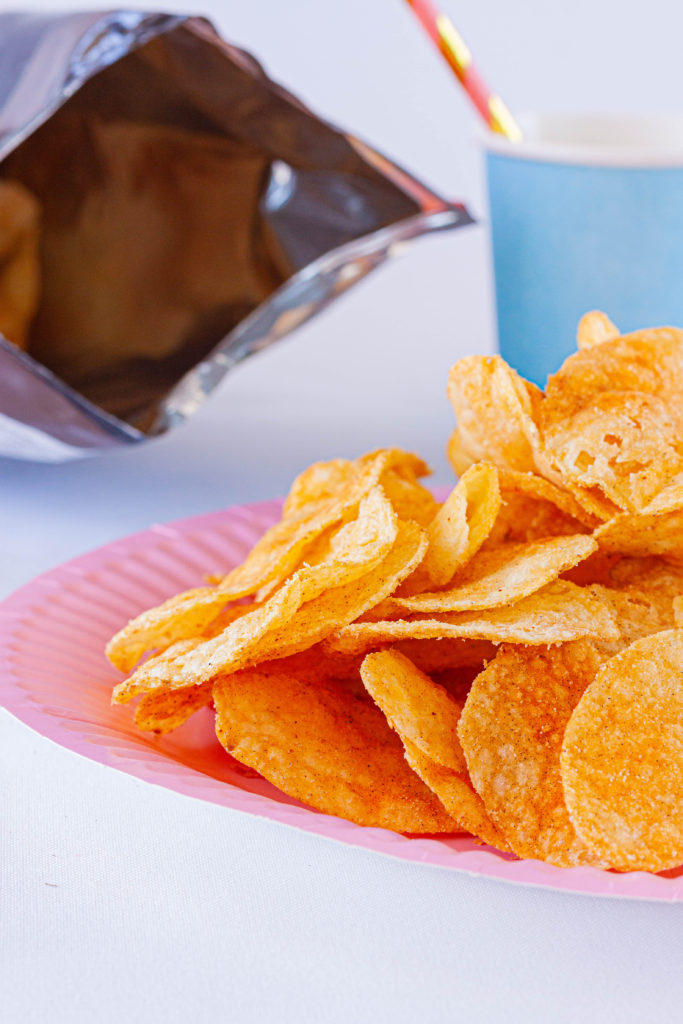
Photo: Hannes Kruger
Are all the nutrients in the skin of the potato?
No, the nutrients of potatoes are spread throughout the tuber and it has been found that there is no specific concentration of nutrients in either the skin or the flesh. According to Hettie and Carmen, the skin acts as a barrier that protects the tuber from nutrient leaching when the tuber is cooked.
According to Michelle, the potato skin does contain fiber which might help with overall gut health.
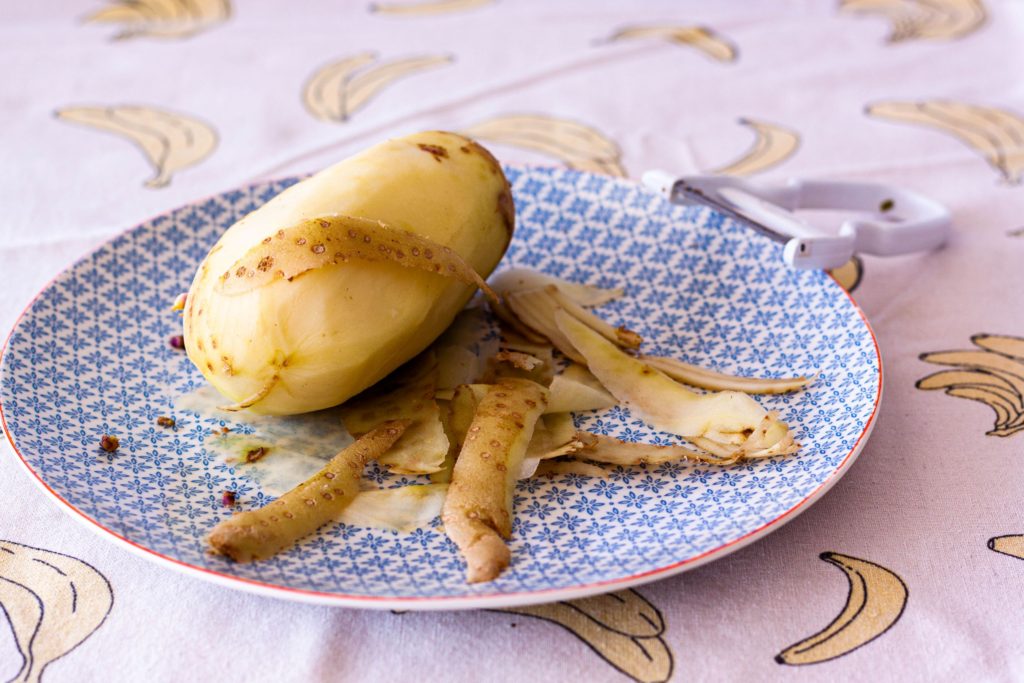
Photo: Hannes Kruger
Do potatoes have a high glycemic index (GI)?
Potatoes do generally have a high GI. Michelle says If you would like to reduce the GI of regular potatoes you can keep the skin on and cook the potatoes, let them cool and then reheat them.
Hettie and Carmen say the GI of a potato is cultivar dependent and how you prepare the tuber.
Should people with diabetes avoid foods like potatoes?
Hettie and Carmen say this is not a simple answer, as it is context specific.
Michelle says as potatoes have a high GI, individuals with diabetes should consume potatoes in moderation.
How do potatoes and sweet potatoes compare when it comes to their nutrition?
Hettie and Carmen say contrary to popular belief potatoes and sweet potatoes do not form part of the same family. Both these tuber crops have a role to play in the diet and deliver valuable and diverse nutrients.
According to Michelle sweet potatoes contain more beta-carotene and have a lower GI. Beta-carotene is a red-orange pigment that gives sweet potato its orange color. When you consume beta carotene, your body converts beta carotene into vitamin A.
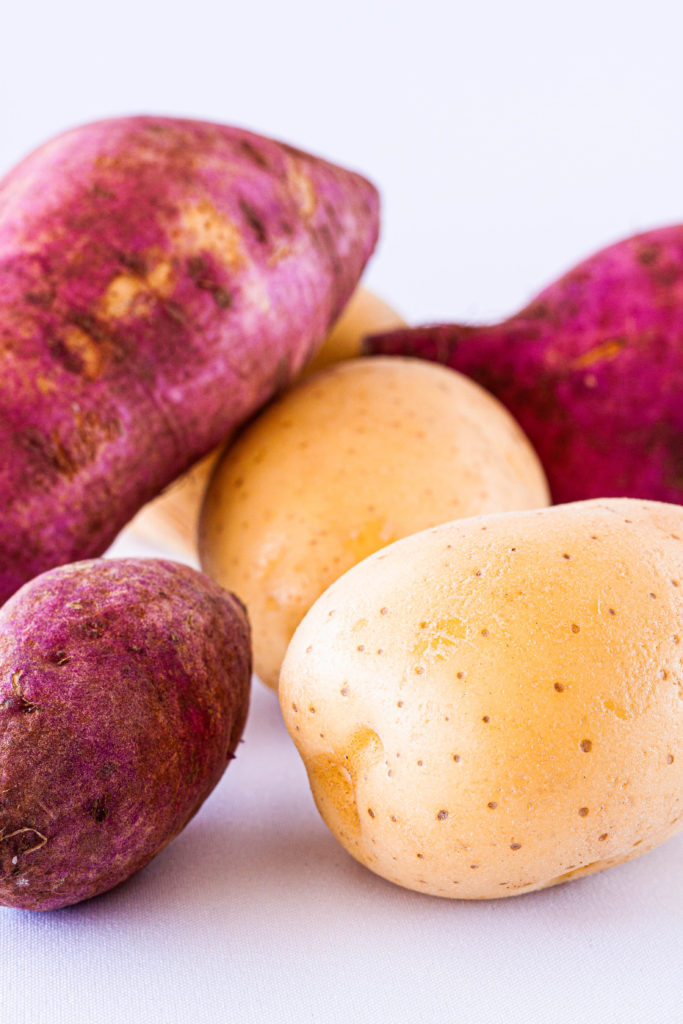
Photo: Hannes Kruger
How healthy is it to have potatoes as a regular consumable in your diet?
Michelle says potatoes provide us with many important nutrients. However, just like any other food, people should eat potatoes in moderation.
Hettie and Carmen say potatoes can form part of a healthy balanced diet when consumed in their original form like baked or steamed potatoes. Potatoes contain an array of necessary nutrients whilst being satiating and versatile.
Information about the potato plant
Prof Jacquie van der Waals, a plant pathologist specializing in potatoes and the program manager of preharvest disease research at Citrus Research International, answers all our questions about the potato plant and gives tips for home growers to successfully grow potato plants in your vegetable garden.
A bit of history: When did the potato become a staple food?
By the early 1800s, the potato was considered a staple food in Europe, although it had been eaten by native South American people as a staple for many centuries prior to that.
Late blight, a potato disease, caused The Great Famine in Ireland between 1845 and 1852. A second, less severe famine, also due to late blight, hit Europe just less than a century later. The Great Famine resulted in the death of approximately 1 million Irish people.
What exactly is late blight?
Late blight is a very destructive disease of potatoes. A fungal-like organism, Phytophthora infestans, cause late blight. Infection of plants by this pathogen causes leaves, stems, and potato tubers to rot. Late blight can cause total destruction of a field within one to two weeks, if environmental conditions are cool and wet, thus favorable for the pathogen. Potatoes may also become infected during harvest and rot in storage.
When is the best time to plant potatoes?
You can plant potatoes year-round in frost-free areas. But if you live in a colder area, you should plant your potatoes in spring.
Is it best to plant potatoes in a pot or directly into your vegetable garden’s soil?
Either can work. Ensure that the clay content of the soil is not too high, and that plants are watered regularly, but not so often that the soil remains wet. It is a good idea to fertilize the plants with a basic fertilizer at planting and flowering.
Which environmental conditions are best for a potato plant to flourish?
Potatoes grow best in temperate climates with long day lengths. The maximum daily temperature should ideally be around 25°C, and not more than 28°C. However, potatoes are sometimes produced at higher temperatures in various growing regions in the world.
When do you harvest potatoes? How do you know potatoes are ready to be harvested?
Harvest the potatoes when the plants die off naturally. This is usually a few weeks after flowering.
How do you harvest potatoes?
Harvest the potatoes by digging them up carefully with a fork. Remove the mother or seed tuber, and any other rotting tubers and discard them. The soil can be dusted off the remaining daughter tubers, and they should be stored in a cool, dark, and well-ventilated place.
When you harvest the potatoes, do you just leave the plant and potatoes grow again or do you remove the whole plant?
It is best to remove the entire plant (the foliage should have died off by harvest anyway), as well as all the tubers.
What are the most significant and common diseases associated with potato plants?
The most common foliar diseases (plant diseases affecting the leaves of the plant) affecting potatoes are early blight and late blight. It is unlikely that home growers will encounter late blight, but early blight and a related disease, brown spot, are common. Early blight and brown spot are caused by the fungal pathogens, Alternaria solani and Alternaria alternata, respectively. Symptoms start as small brown to black lesions (spots) on leaves, and will increase in size in warm, wet weather. Symptoms usually begin to appear during or just after flowering.
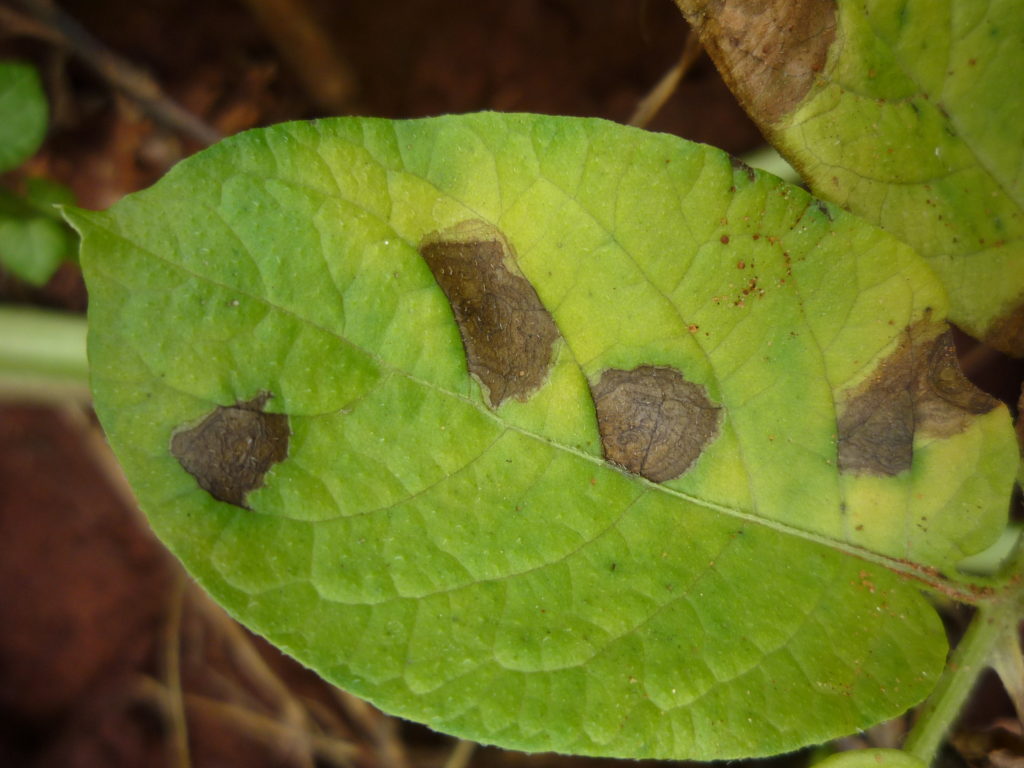
Photo: Jacquie van der Waals
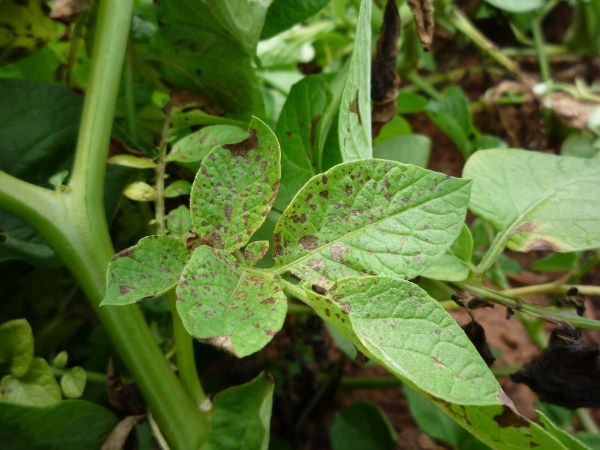
Photo: Jacquie van der Waals
Various other pathogens can infect potatoes that cause wilting and yellowing of the plants. The most common of these wilt pathogens is a bacterium, Pectobacterium brasiliense, which is seed-borne and will cause wilt, blackleg or soft rot of potato plants and tubers under warm and wet conditions.
There are also a number of tuber blemishes that affect potatoes, but these are not observed on the leaves of the growing plant. They will be seen on the tubers at harvest. Most tuber diseases (except for soft rot) are merely cosmetic. You can peel off the lesions and eat the tubers.
How can potato home growers prevent their potato plant from getting a disease?
I do not advise home growers to spray plants preventatively against any pathogens. Harsh chemicals are not good for the environment. However, should the home grower choose to protect their plants from pathogens, they can use a contact fungicide from the time of flowering, on a 7-10-day basis, or a biological control agent containing Bacillus spp. or Trichoderma spp. These biological products would need to be applied from planting to harvest. Both fungicides and biological control agents are available from nurseries or agricultural co-operatives.
The best non-chemical approaches to keeping your potato plants healthy are the following:
- Make sure your soil is well-drained
- Ensuring to not give your plants too much water or fertilizer
- Make sure the plants are not planted too close to each other
If my potato plant gets a disease, how should you treat it or would it be best to remove the plant?
If early blight or brown spot become very severe, the home grower can purchase a systemic fungicide and spray this as per instructions. Take careful note of safety instructions.
If the plants begin to wilt, show blackleg symptoms and die off prematurely, it would be best to remove the plant and rotting tubers from the garden.
What do I need to feed my potato plant?
Work compost into the soil at least a month before planting. At planting, apply a general fertilizer as recommended by your local nursery and apply again at flowering.
How regularly do I need to water my potato plant?
The soil must be moist but never wet. Irrigate (water) twice a week, making sure it’s just enough water to make the soil moist. Give your potato plant less water during the rainy season.
What type of soil do potato plants like?
Potato plants like fertile soil that is well-drained and well-aerated. Sandy loam soils are best. Avoid high clay content soils.
What influence does a potato plant’s disease have on the soil? How do you treat the possibly contaminated soil?
Some of the tuber pathogens can survive in the soil for extended periods of time and thus infect future potato crops, and other alternative hosts planted between potatoes.
The best “treatment” for such soil-borne pathogens is integrated management:
1. Practice crop rotation: Plant potatoes once every 4 to 5 years in the same soil. In alternate years, plant legumes, brassicas, and grasses.
2. Incorporate compost into the soil between each crop.
3. Apply biological products that improve soil health. It is best not to treat soils chemically, as this disrupts the microbial balance in the soil.




1 thought on “The Potato”
This was such an informative article! Thank you. I learned loads of new things! Especially interesting was the nutritional content. Now I can properly justify my love of potatoes!